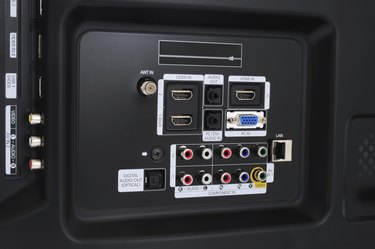
Many high-definition televisions play digital videos and music directly from connected hard drives, so long as the files are a supported format. For unsupported formats, other devices such as set-top boxes, media-player-equipped hard drives and your computer can bridge the gap between your media and your TV. These devices are necessity if you have an older TV that lacks a built-in media player.
Connecting to USB Ports
Video of the Day
The simplest means of connecting your hard drive to your TV is using USB. Most newer televisions have one or more USB ports for connecting a pocket-sized flash drive, or an external hard drive using a USB cable. If your TV doesn't have powered USB ports, however, only drives with an independent power supply will work.
Video of the Day
After the drive is connected, compatible files on the hard drive are accessible using the TV's built-in file explorer app. Most TVs require the drive to be formatted using a specific file system in order to be compatible, typically using FAT32 or NTFS. Consult your owner's manual for specifics on what file system your TV requires.
To connect the drive, insert the connectors on each end of the cable into the corresponding ports on the TV and drive, or in the case of flash drives, directly insert the drive's connector into the TV's port.
Identifying Compatible Content
Just because your TV features USB connectivity doesn't mean that every file you have stored on your drive is compatible. While most USB-enabled TVs are compatible with a variety of image, video and audio formats, there isn't a standard for what content TVs support. In order to determine just what media you can watch on your TV from the drive, consult your owner's documentation or the manufacturer's website. Some formats more likely to enjoy support than others include JPEG images, MP3 audio and MP4 video.
Viewing Hard Disk Content
Just as different TVs support different file formats, the method they employ to display the files varies from one TV to the next. In most cases, the drive is selectable from the Input list like any device connected to HDMI or Composite and accessed by an interface app installed on the TV. How the interface works again varies from one TV to the next, so consult your owner's documentation for specific instructions on accessing data on your drive.
Using Multimedia Hard Drives
If you're using a hard drive with a built-in media player, like the WD Elements Play or Sumvision Cyclone Primus, things work a bit differently. These drives have their own set of compatible file formats but display video regardless of what formats your TV supports. They also have their own built-in user interface and typically their own remote control.
Instead of using USB ports, these drives use video inputs like HDMI or Component to connect to the TV. If a file doesn't display on your screen, it's likely that the drive's codecs need to be updated, or the drive doesn't support the format. Consult your owner's manual for specific information regarding what formats your drive supports.
Using Other Devices as Intermediaries
In some cases, such as when your files are in a format incompatible with your TV's built-in software, it's easier or more practical to use another device instead.
Connecting the drive to a computer, then connecting the computer to the television, can be an effective means of overcoming a lack of format support in your TV. A PC-to-TV A/V connection using a cable like HDMI effectively turns your TV into a large-scale monitor, which displays any video played from your computer so long as your preferred media player app is compatible with the file.
Set-top boxes like Roku and dongles like Chromecast are also options, as they connect to devices in your local network like your computer and stream content to your television. What formats are supported varies from one device to the next, so consult your owner's manual for specific information regarding your device.